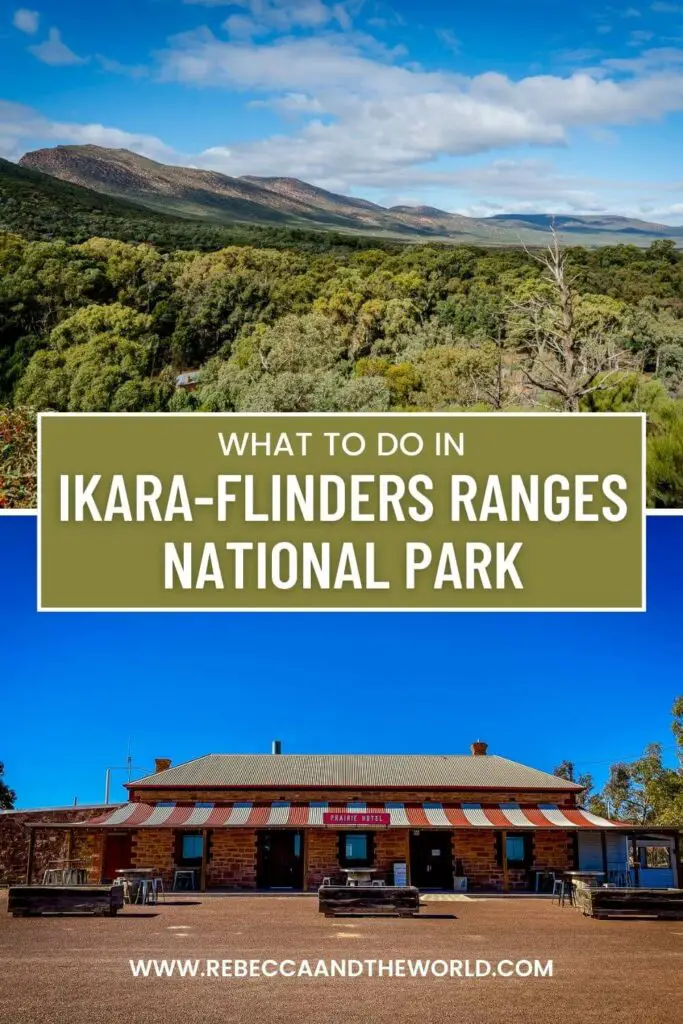Looking for the best things to do in Ikara-Flinders Ranges National Park? This guide covers what to do and see, where to stay and how to get here.
South Australia’s most iconic national park, visiting Ikara-Flinders Ranges National Park feels like you’re stepping back in time. To visit here is to tread on some of the oldest geological formations on Earth that date back a staggering 600 million years.
With its abundant wildlife, rugged mountain peaks and deep gorges cutting through the landscape, there’s no other place quite like it. If you’re looking for an Outback Australia experience that’s accessible yet still untamed, Ikara-Flinders Ranges National Park is the place to be.
I spent five days in Ikara-Flinders Ranges National Park and every day was filled with hiking, sightseeing and exploring Outback towns. There’s a lot to do here and in the surrounding area.
Here are the best things to do in Flinders Ranges National Park, along with handy visitor information.

This blog post may contain affiliate links, meaning if you book or buy something through one of these links, I may earn a small commission (at no extra cost to you).
About Ikara-Flinders Ranges National Park
The Adnyamathanha people are the traditional owners of the land that makes up Ikara-Flinders Ranges National Park.
Stretching over almost 1,000 square kilometres, the national park is located approximately 400 kilometres north of Adelaide in South Australia. It’s named after the spectacular Flinders Ranges, a group of ancient mountains that have long been a favourite for hikers, campers and nature enthusiasts.
The highlight of Ikara-Flinders Ranges National Park is Wilpena Pound, a natural amphitheatre created by the erosion of a once-mighty mountain range. Adnyamathanha stories tell of two serpents who ate everyone at a ceremony here and whose bodies now form the walls of Ikara.
Wilpena Pound has to be seen to be believed – it’s actually eight times the size of Uluru and 300 metres taller, which gives you some idea of just how incredible this place is.
The Adnyamathanha word for Wilpena Pound is Ikara, which means “meeting place”, recognising the area’s significance as a place for cultural gatherings. Ikara was added to the national park name in 2016.
Despite its grandeur, Wilpena Pound/Ikara remains relatively unknown to many Australians – I’d never heard of it until I listened to a podcast a few years ago! But once you see it, you’ll never forget it.
What to know before visiting Ikara-Flinders Ranges National Park
Entry fees
It costs $13 per vehicle to enter Ikara-Flinders Ranges National Park. Buy your permit online ahead of time.
Phone reception
Phone reception is patchy at best in the park and some areas may not have any signal at all. We had decent coverage at Wilpena Pound Resort (in the campground) but once you hit the walking trails it disappears pretty quickly. Download offline maps and the “Discover the Flinders Ranges” app.
Fuel
The closest town to the national park is Hawker. There’s a service station here – but of course, fuel is more expensive than Port Augusta. There are also fuel stations at Ransley Park Station and Wilpena Pound Resort. As you can probably guess, fuel is even more expensive at those two places.
Road hazards
The road to the national park is sealed, including to Wilpena Pound Resort. Keep an eye out for wildlife, especially around dawn and dusk – we had a couple of kangaroos hop across the road in front of us as we drove in on our first day, and on most days we saw the resident mob of emus wandering by the side of the road.

Firewood
If you’re camping in Flinders Ranges, then make sure you bring firewood with you. You can’t collect firewood from within the national park. The shop at Wilpena Pound Resort sells bundles (from memory, we paid $25 for a small-ish bundle that lasted us two days).
No fires are allowed between November and April.
Dogs
Like all national parks, dogs aren’t allowed in Ikara-Flinders Ranges. If you’re travelling with your pet, you can stay at Rawnsley Park Station.
Things to do in the Flinders Ranges National Park
There are plenty of things to do in Ikara-Flinders Ranges National Park, most of them involving the outdoors so you can experience the wild beauty of this national park.
1. Stop in at the visitor centre

Your first stop at the national park should be the visitor information centre, which is inside Wilpena Pound Resort. Pick up a map of the national park and hiking trails, and check the latest road conditions.
There’s also a shop here so you can buy food and drinks as well as fill up fuel.
2. Welcome to Country
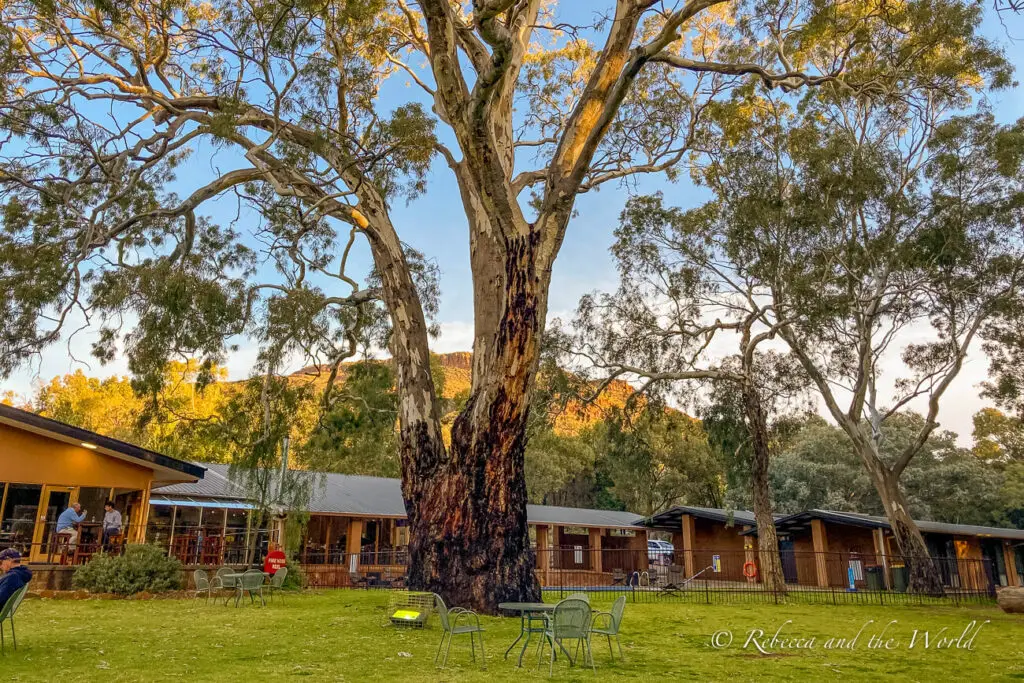
Start your visit to this culturally significant land by joining the daily Welcome to Country. Every evening, an Adnyamathanha guide welcomes visitors in the Yura Ngawarla language and shares traditional stories of the Dreaming (called Yura Muda).
The Welcome to Country is held on the lawn in front of reception, under the huge tree. From March to November, it’s at 4.30pm, and at 6pm from December to February.
3. Wilpena Pound walks
Ikara-Flinders Ranges National Park is all about the hikes. Getting out on foot is the best way to see the national park, learn about its geology and hopefully spot some wildlife.
There are hikes for every fitness level. Here are some of the ones we enjoyed.
Arkaroo Rock
Distance: 3.1km loop
Class: Grade 3, Moderate
It’s a roughly 20-minute drive from Wilpena Pound Resort to Arkaroo Rock. This is a significant cultural site for the Adnyamathanha people, and the climb leads to a rock shelter with ochre and charcoal rock art.
The rock shelter is surrounded by a cage to protect the paintings, but you can still see them easily and can stick your camera lens right up to a gap in the fence to get a good photo. The light is better for photos in the morning.
While there’s no signage at the shelter, the paintings are of the Dreaming, or creation story, of Ikara/Wilpena Pound.
The trail is a bit rocky, so make sure you have the right shoes. There are toilets at the car park.
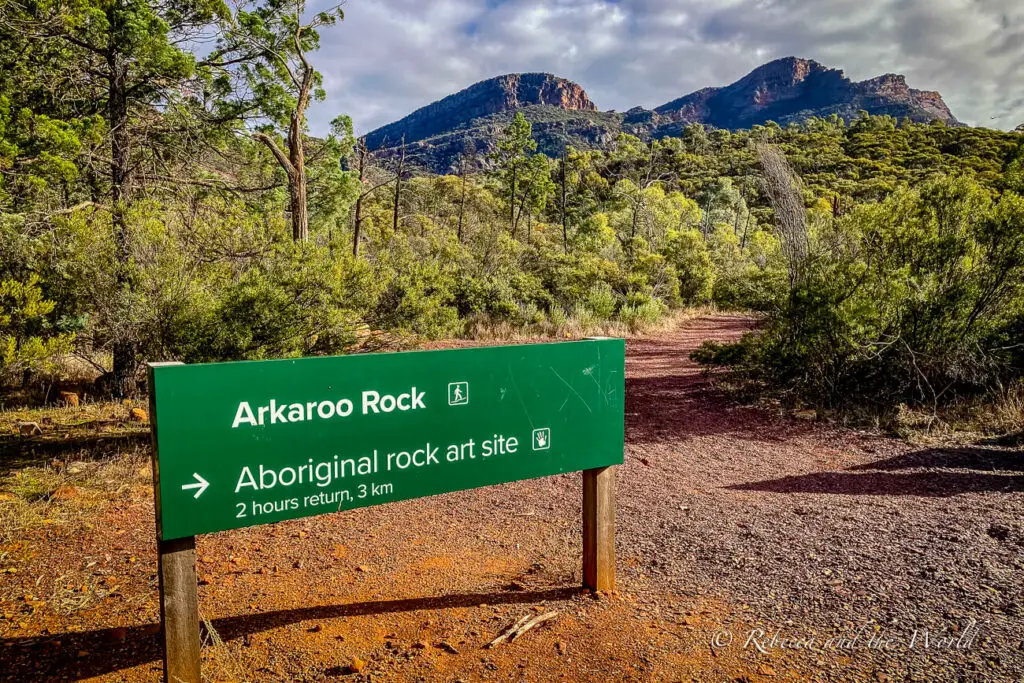
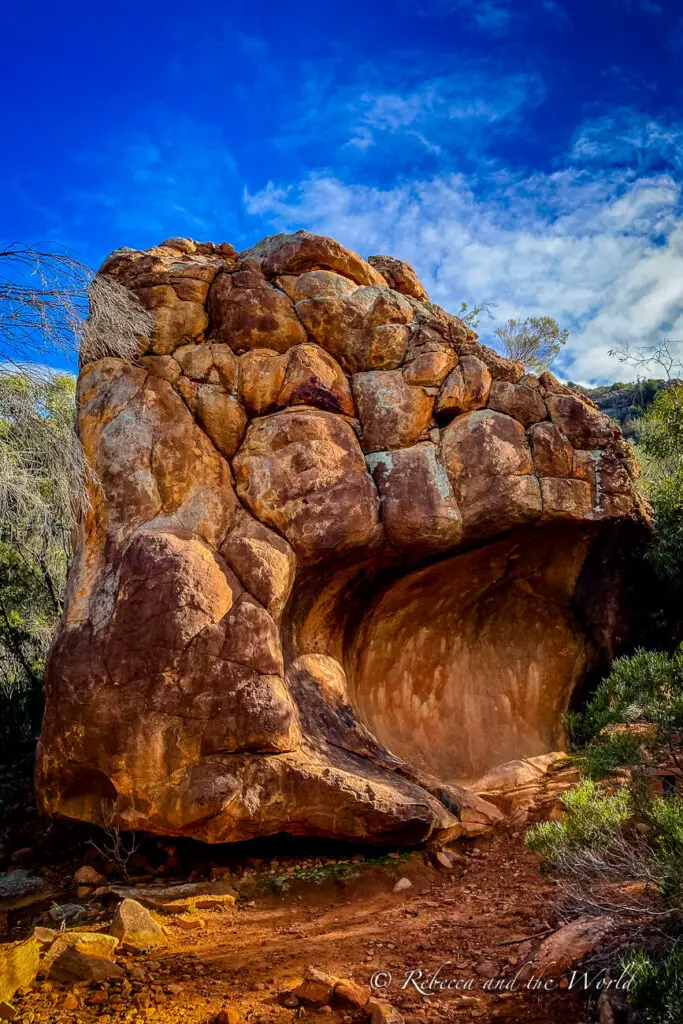

Hills Homestead
Distance: 6.6km return
Class: Grade 1, Easy
This trail – like all the others I’ll talk about next – starts at the main trailhead at Wilpena Pound Resort.
It leads through lovely bushland to an old homestead that was owned by one of the first pioneer families that lived in the area. The trail here is pretty flat.
What I like about this walk is that there’s plenty of signage that shares the perspectives of both the pioneers and the Adnyamathanha people who lived here – Jessie Hill and Eileen Coulthard respectively. As you can imagine, both had very different experiences of living in this area.
On this trail, you’ll even be hiking a small part of the 1200-kilometre Heysen Trail, which stretches from Cape Jervis in the Fleurieu Peninsula to Parachilna Gorge in the Flinders Ranges.
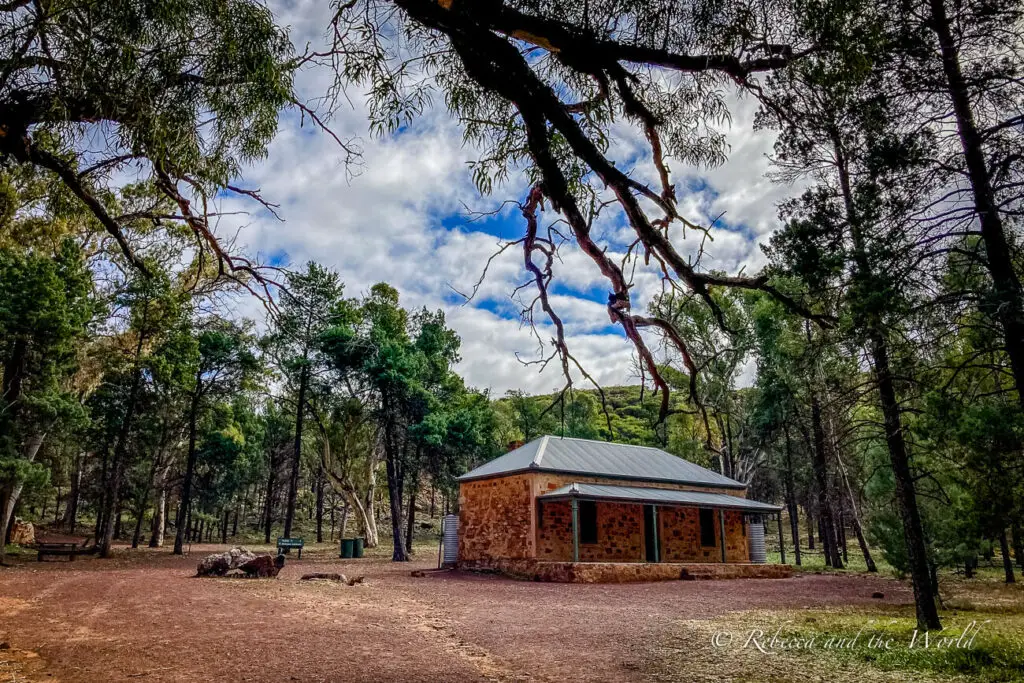
Wangara Lookout
Distance: 7km return to the upper lookout, 6.2km return to the lower lookout
Class: Grade 4, Hard
This trail is actually a continuation of the Hills Homestead walk. Keep going beyond the homestead, past the carving of two Indigenous men and then tackle the fairly steep climb up to the lower lookout.
If you’ve got the stamina, keep going the extra few hundred metres to the upper lookout.
From both lookouts, you’ll have spectacular views of Ikara/Wilpena Pound. If you’re not tackling one of the longer trails (see next hikes), then I think this hike gives you the best perspective of the Wilpena Pound wall and a sense of actually being inside this geological wonder.



St Mary Peak (Ngarri Mudlanha)
Distance: 19km circuit (or can be done as a the 14.6km return hike)
Class: Grade 4, Hard
We ummed and ahhed about doing St Mary Peak, the highest mountain in the Flinders Ranges. We’d heard that it was really hard – and I’m afraid of heights. In the end, I’m glad we decided to take on the challenge because it was absolutely beautiful.
The first thing to note is that St Mary Peak plays a central role in the Adnyamathanha creation story. So the Adnyamathanha ask that visitors don’t climb to the summit of the peak. You can climb to the Tanderra Saddle to respect their wishes – and to be honest, the views from this ridge are more than enough. This is where we got to and I was blown away by the scenery.
The hike to Tanderra Saddle does have some tricky rock climbing – my husband had to pull me up the rocks at times because my legs just weren’t long enough. Directional signage is also lacking in some of the rocky areas, so stick close to your walking buddies! Friends we made at the Wilpena Pound campground got lost from each other.
You can do the hike as an in and out which is 14.6km, but I’d recommend continuing on to do the full loop (19km) – mostly because there was no way I was going back down the rocks! Start on the “outside trail” because then the final part of the loop (the “inside trail”) will be flatter and easier. Either way, you’ll be feeling all your leg muscles the next day!
This hike is closed over summer because of the heat.


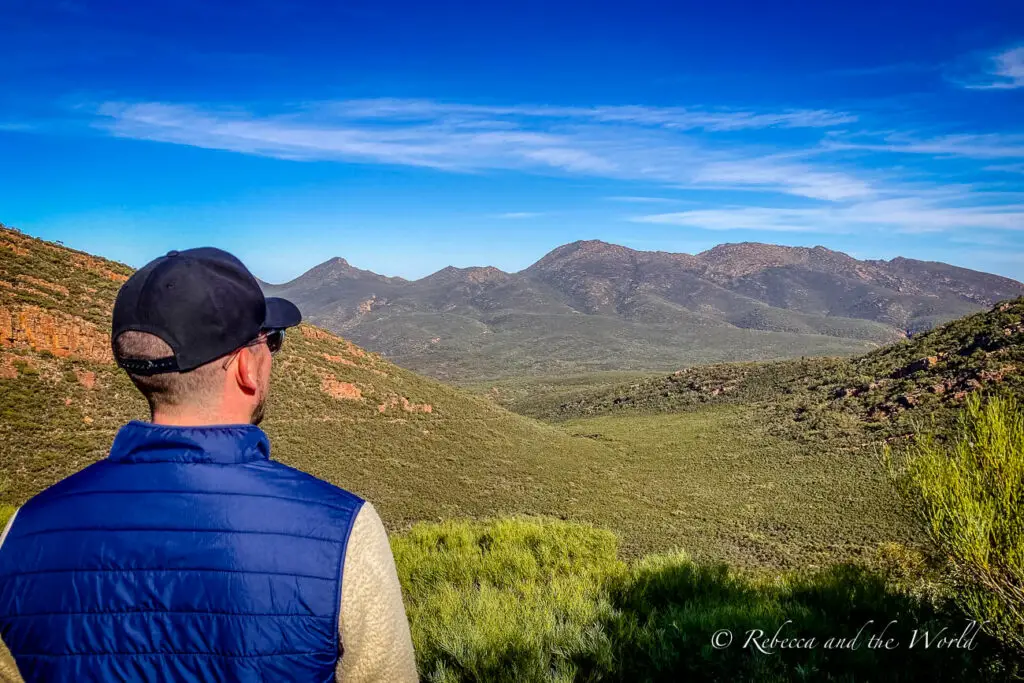
Mount Ohlssen Bagge
Distance: 5.6km return
Class: Grade 4, Hard
Looking for another challenging Wilpena Pound walk? If St Mary Peak didn’t get your legs burning, then hit the Mount Ohlssen Bagge trail.
It’s steep but the views at the top are worth the effort – they’re on par with (if not better than) the views from Tanderra Saddle.
Like St Mary Peak, there’s a bit of rock-scrambling required to get to the top. Bring plenty of sunscreen and a hat because most of the trail is exposed.
This trail is also closed during the summer months.


Expert tip for hiking in Wilpena Pound! We tackled a new trail every day, and to be honest, we got a bit bored of the walk from Wilpena Pound Resort to the trailhead (it’s only about 2kms but we were always eager to get started on the actual hike!). If you’ve got bikes, ride them to the trailhead to save some time. Alternatively, there’s a shuttle from the visitor centre every couple of hours that costs $8 per person.
4. Flinders Ranges tours with a First Nations guide
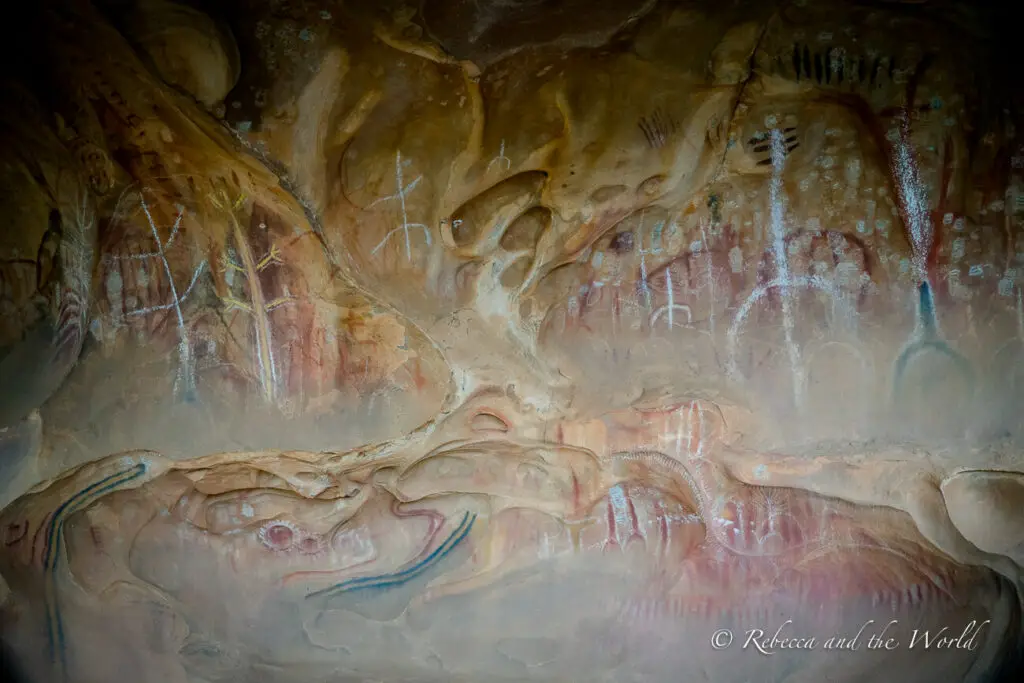
Because this land is so sacred, join a tour with one of the Yura guides to better understand why this area has been so important to the Adnyamathanha people for tens of thousands of years.
The only way to visit Sacred Canyon (Yura Malka) is with a guide, and it’s the best way to understand the stories behind all the ancient engravings that have been carved into the sandstone walls of the gorge.
The guides we met while staying at Wilpena Pound Resort were entertaining and great storytellers.
Tours can be booked at the Wilpena Pound visitor centre or online.
5. Lookouts at sunset

Head up to a lookout at sunset to be absolutely blown away by the scenery. Pictures really don’t do the landscape of Flinders Ranges justice.
Watching the sun dip below the rugged red cliffs and illuminate the vast expanse of the national park is a truly unforgettable experience. Some popular lookout spots for sunset are Stokes Hill Lookout, Razorback Lookout and Arkaroo Rock.
Hucks Lookout has some interpretive signage that explains how the Flinders Ranges were formed – just between a mere 1000 and 500 million years ago!
6. Star gazing

Out here in the South Australian Outback, the stars are incredible. Thanks to the remote location and minimal light pollution, on any clear night, countless stars and celestial bodies are visible to the naked eye in Flinders Ranges.
Step outside your tent/caravan/cabin to take in the views. Or head up to Stokes Hill Lookout or Arkaroo Rock for some stargazing.
7. Scenic flight

It’s hard to get a proper perspective of the size of Ikara/Wilpena Pound from the ground, so head to the skies instead.
A scenic flight is the best way to see this stunning landmark, as well as the surrounding landscape.
Flights take off from Wilpena Pound Resort and Rawnsley Park Station and last between 20 minutes and an hour.
With prices starting at $190 per person for 20 minutes, it’s definitely an Australian bucket list experience!
8. Wildlife spotting

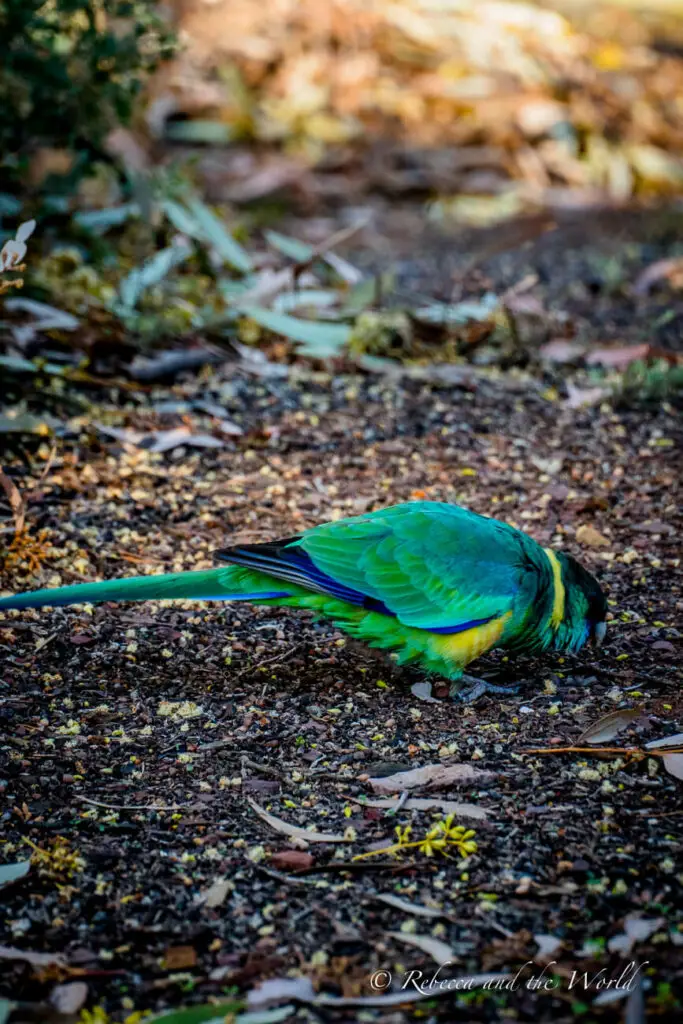
When you’re hiking through Flinders Ranges National Park, chances are you’ll spot some wildlife.
The elusive yellow-footed rock wallaby is the park’s most iconic resident. We only spotted one the entire time we were in the Flinders Ranges. We saw this cutie through the trees when we were walking back from the trailhead to Wilpena Pound Resort, but he was quick to move once he knew we’d spotted him.
Keep your eye out for the local mob of emus that inhabit the area around Wilpena Pound Resort. I had no idea that the male emus raise the chicks. You’ll see these single dads leading their chicks around.
You’ll also likely spot western grey kangaroos and euros, a type of kangaroo common to the area.
I loved spotting the Australian ringnecks, with their almost neon-green feathers and yellow-ringed necks, and we saw a few wedge-tailed eagles in the distance.
Most unexpected was the feral goats we saw! These goats are an introduced species and have slowly taken over the park – although work is underway to reduce the population.
9. Brachina Gorge Geological Trail

One of the best things to do in Flinders Ranges National Park is the Brachina Gorge Geological Trail.
This 20-kilometre self-guided trail takes you through 130 million years of Earth’s history. Along the route, you can observe ancient sea beds, fossil remnants and evidence of past climates and environments. There are plenty of information boards explaining the geological significance of each particular spot.
Even if you’re not that into rocks and history, the Brachina Gorge itself is an impressive sight to behold, with its steep cliffs and dry river bed.
You can also combine this drive with Bunyeroo Gorge Road, to loop back to the Flinders Ranges Way or Outback Highway. There’s a great hike here, too, which starts at the Bunyeroo car park. It’s a 9.2km loop, so make sure you start early enough in the day. Depending on what the rains have been like, you may have to do some water crossing, so prepare accordingly!
While most people recommend doing this trail in a 4WD, we did see some 2WD cars tackling it! Check the road conditions before you head out.
10. Moralana Scenic Road

The Moralana Scenic Road is one of the top attractions in Flinders Ranges National Park. We loved the scenery along this 29-kilometre-long drive through towering red cliffs and sprawling pastoral lands.
You’ll get a stunning view of the outer walls of Wilpena Pound and the Elder Range. While we drove the road during the day, I hear that it’s especially striking during sunrise or sunset.
There are several pull-offs along the road where you can stop for photographs. It’s not as busy as the Brachina Gorge/Bunyeroo Road – we saw only a handful of cars along the way.
Again, we also saw some 2WDs driving the gravel road, so it is possible – just be extra careful after rain and drive slowly.
11. Visit Blinman

To break up our hike days, we took a little day trip to Blinman, about an hour from Wilpena Pound Resort. This little town’s claim to fame is being the highest town in South Australia.
Blinman has a mining history dating back to the 1850s. Though the mines are now silent, it’s a cute little one-street town that’s worth a visit.
Take a guided tour of the Blinman Underground Mine, where you can learn about the town’s copper mining past. You’ll need to book a tour ahead of time. Even though tours are offered on the hour during peak travel months, I was surprised at how quickly they fill up.
For me, the highlight of Blinman was the bakery. I tried my first quandong pie here – they’re famous around this area. Blinman is also famous for the “miners pasty” – a classic Cornish pasty with a section of apple pie at the end!
The Miners Crib also has interesting pie flavours like goat curry, kangaroo and red wine, and pork and gravy. Make sure you plan a trip through Blinman for morning tea or lunchtime so you can try one of their yummy pastries.
12. Feral feast at the Prairie Hotel

Combine a trip to Blinman with a visit to the Prairie Hotel in Parachilna. The road between Blinman and Parachilna is dirt and it’s rocky with some small creek crossings, but it’d be okay in a 2WD.
Literally in the middle of nowhere, the Prairie Hotel is an unexpectedly classy little pub. It’s famous for its “feral feast” – a mixed grill of charred roo fillet, camel boerwors sausage, emu rissole and goat tomahawk topped with red wine jus.
It’s HUGE and I couldn’t eat it myself, so I went with the surprisingly gourmet fish dish, which was grilled Coorong mullet with five-layer potato gratin and a lemon butter sauce. As I said, very unexpected for the Outback.
The Prairie Hotel is closed on Monday and Tuesday.
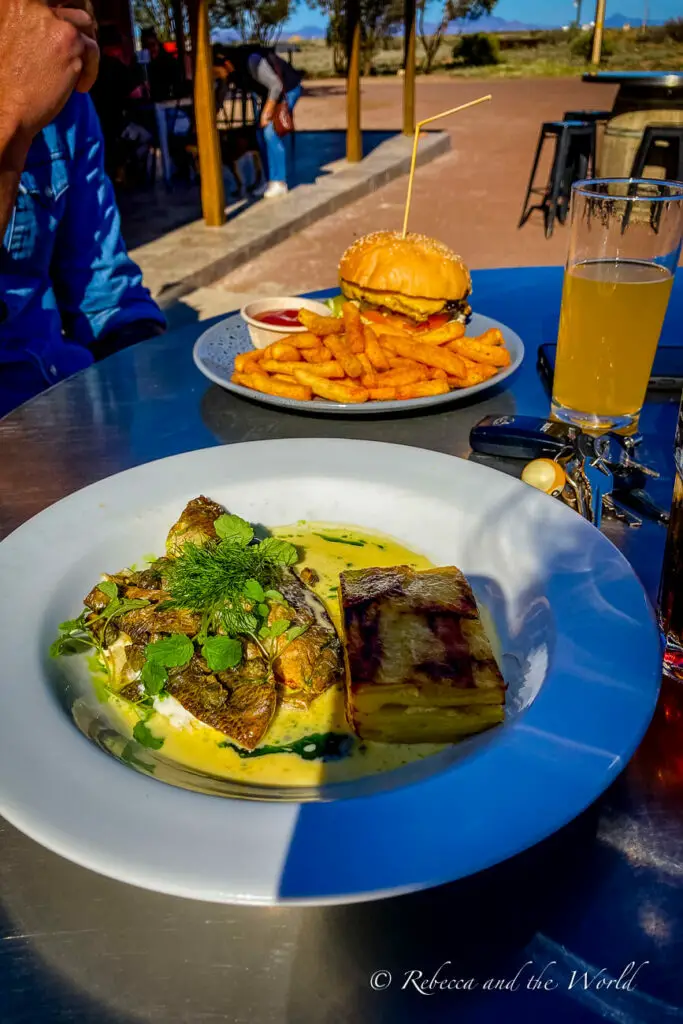
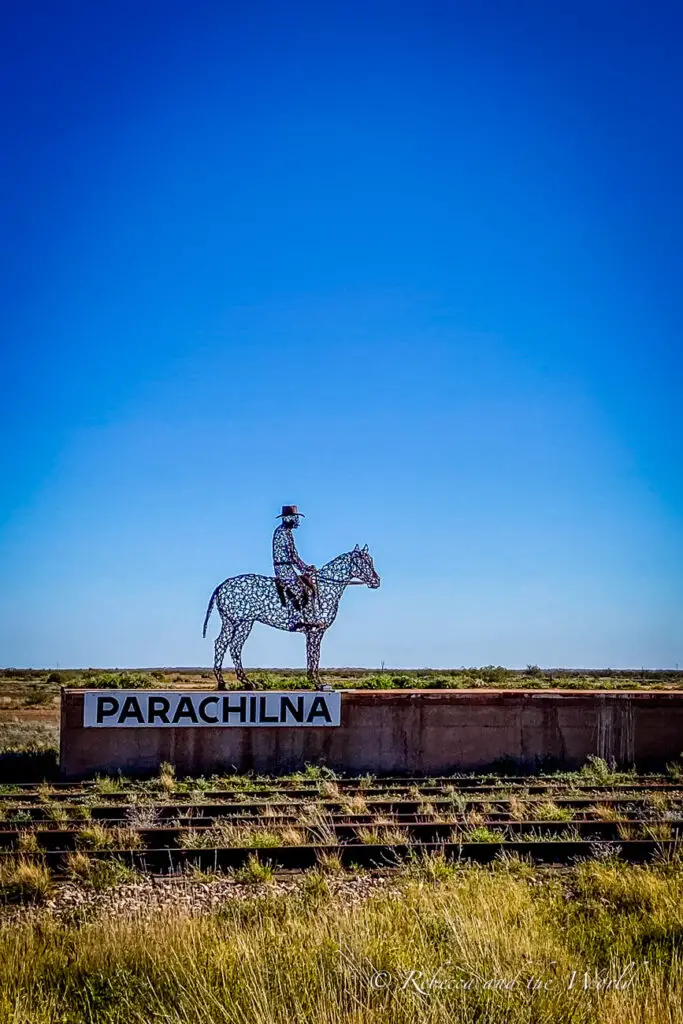
13. Stop at Hawker

On your way in or out of Ikara-Flinders Ranges National Park, stop at Hawker. Beyond just filling up with fuel, fuel up with a meal at the lovely Flinders Food Co, another unexpected hipster cafe in the middle of the Outback. While service was a bit slow, the food and coffee were good.
Hawker is also home to the Jeff Morgan Gallery, which showcases stunning oil paintings of the Flinders Ranges and outback landscapes. These huge paintings make you feel like you’re right in the Flinders Ranges, so it’s a good taster for what’s about to come – or a final experience as you leave the national park.
Flinders Ranges itinerary ideas
There’s a lot to do in Flinders Ranges National Park, so to make planning easier, here are a few itinerary ideas.
2 days in Flinders Ranges itinerary
Day 1:
Start your day early with a stop at Hawker, where you can fuel up both your car and your stomach. Enjoy a delicious meal at the Flinders Food Co and take a moment to appreciate the beautiful oil paintings at the Jeff Morgan Gallery.
Next, head straight to Ikara-Flinders Ranges National Park. Tackle one of the shorter hikes, like the Hills Homestead/Wangarra Lookout trail.
Day 2:
On the second day, make your way to Blinman. Take a mine tour and grab a miners pasty from the bakery. Head to Parachilna and see if you can tackle the famous “feral feast” at the Prairie Hotel. Head back to Wilpena Pound via the Moralana Scenic Drive or Brachina Gorge Geological Trail.
3 days in Flinders Ranges itinerary
Follow the 2-day Flinders Ranges itinerary above. On day 3, hit the trails for another hike. If you’ve got the stamina, try St Mary Peak or Mount Ohlsson Bagge. For something easier, Arkaroo Rock is a good stroll that ends with beautiful rock paintings. Finish your day with a sunset view from Stokes Hill Lookout.
5 days in Flinders Ranges itinerary
Continue following the 3-day Flinders Ranges itinerary above.
Day 4:
Start your day with a visit to the Bunyeroo and Aroona Valleys, known for their breathtaking landscapes. Next, head to the Great Wall of China, a rock formation that showcases millions of years of geological history. Spend the rest of your day exploring the Brachina Gorge. If you’re lucky, you might spot the yellow-footed rock wallaby.
Day 5:
Your final day should definitely include a visit to the Sacred Canyon. The walk might be short, but the ancient Aboriginal engravings make the trip well worth it. End your day, and your Flinders adventure, with a scenic flight over Wilpena Pound.
Ikara-Flinders Ranges National Park accommodation
There’s plenty of accommodation in Flinders Ranges National Park for all budgets and tastes.
Wilpena Pound Resort
To be right in the national park, stay at Wilpena Pound Resort. It has a range of accommodation options, from camping to motel-style rooms and safari-style glamping tents.
We booked a powered campsite and it was a good size with a firepit. The campsites are suitable for tents, camper trailers (like we had) and caravans. There’s also a spacious unpowered section.
There’s a restaurant/bar, pool and supermarket on site.
CHECK RATES AND AVAILABILITY AT WILPENA POUND RESORT

Rawnsley Park Station
Another great option for lodging is Rawnsley Park Station, one of the oldest stations in the area. It’s just outside of the park, on the southern side of Wilpena Pound. Accommodation here ranges from affordable cabins to luxurious eco-villas, as well as caravan and camping facilities. It’s dog-friendly for those travelling with pets.
The station is also home to the excellent Woolshed Restaurant.
CHECK RATES AND AVAILABILITY AT RAWNSLEY PARK STATION
Arkaba Conservancy
For a truly luxe Flinders Ranges accommodation experience, book a stay at Arkaba Conservancy. Situated on a 60,000-acre wildlife conservancy, Arkaba has an authentic Australian homestead with amazing views of the Flinders Ranges. The main homestead has 5 rooms. The accommodation provides all-inclusive meals and beverages.
Prairie Hotel
While not as conveniently located to the national park as the other accommodations listed above, the Prairie Hotel in Parachilna does have a distinctive outback character. The hotel’s stylish accommodation ranges from budget-friendly options to more luxurious suites.
CHECK RATES AND AVAILABILITY AT PRAIRIE HOTEL
Ikara-Flinders Ranges National Park camping
Camping in the Flinders Ranges is a great way to really experience the raw beauty of Ikara-Flinders Ranges National Park.
Parks SA has several campsites in the national park, ranging from walk-in to 2WD and 4WD accessible. Fees start from $11 a night.
More information is on the Parks SA website. Campgrounds include:
- Acraman – 4 sites
- Aroona – 13 sites
- Brachina East – 13 sites
- Cambrian – 13 sites
- Dingley Dell – 8 sites
- Koolamon – 14 sites
- Teamsters – 5 sites
- Trezona – 15 sites
- Wicolo – limited walk-in sites
- Youngoona – 4 sites
All are unpowered and have toilet facilities.
What to pack
When preparing for your visit to Flinders Ranges National Park, especially if you’re planning on hiking, here are some essentials to pack:
- Hiking boots: Sturdy, comfortable footwear is a must-have. Look for boots with good ankle support and non-slip soles. I like these Columbia hiking boots.
- Backpack: Make sure it’s comfortable and has enough space for all your items.
- Water bottle: Always carry a refillable water bottle. I also like having a water bladder when I’m hiking.
- Sun protection: Don’t forget your hat, sunscreen and sunglasses to protect yourself from the intense Australian Outback sun. I also wore a long-sleeved shirt when hiking.
- Snacks: Pack high-energy snacks such as trail mix, energy bars and fruit.
- First aid kit: Include band-aids, antiseptic wipes, tweezers and any personal medication.
Want a more detailed packing list? Check out my Outback Australia packing list, which covers everything you need to take to this iconic part of Australia.

Best time to visit Ikara-Flinders Ranges National Park
The best time to visit Flinders Ranges is between April and October when the temperatures are more moderate and better for hiking and camping. Temperatures are usually between 20°C (68°F) and 30°C (86°F).
During the winter months, nighttime temperatures can dip significantly, but days are sunny and pleasant. We visited in June and had lovely days where we could get away with a light jumper, but appreciated our firepit at night and the heater in our camper trailer!
If you can tolerate the heat, the park is quieter from December to February. However, temperatures during this period can reach up to 40°C (104°F), and many hiking trails are closed completely.
Check road conditions at any time of year. Rain can wash away roads.

How to get to Ikara-Flinders Ranges National Park
Ikara-Flinders Ranges National Park is the gateway to the Outback and is easily accessible. From Adelaide to Flinders Ranges National Park it’s a five-hour drive north. The drive is scenic and dotted with small towns (and a few vineyards, depending on the route you take) where you can take breaks. Rent a car in Adelaide (or you can even rent a campervan). You can get away with a 2WD for most of your visit to the national park, but a 4WD means you’ll have an easier run on some of the dirt roads.
From Port Augusta, the journey is considerably shorter, roughly 160 kilometres. The most straightforward way is to take National Highway B83. This drive should take you around 2 hours, passing through the towns of Quorn and Hawker.
If you’re coming from Coober Pedy, it’s about a seven-hour drive. The most direct route is via the Stuart Highway/A87. This route takes you through some of South Australia’s most unique and rugged landscapes and is an adventure in itself.
Doing the epic Adelaide to Darwin drive? It’s one of Australia’s best road trips, and you should definitely take a detour to Ikara-Flinders Ranges National Park.
Flinders Ranges Tours
Prefer to take a guided tour of Ikara-Flinders Ranges National Park?
Experience a 3-day eco safari from Adelaide that immerses you in Australia’s unique wildlife, wilderness and Aboriginal culture. During the tour, you’ll explore the Flinders Ranges National Park, Wilpena Pound and Brachina Gorge on this small-group tour. Book online now.
On this 5-day outback safari through the Flinders Ranges, you’ll explore iconic landmarks like Wilpena Pound and Arkaroola Wilderness Sanctuary, experience Indigenous culture and see diverse wildlife. Book online now.
After a truly luxe tour? The Arkaba Walk is a hosted walk with amazing food, wine and accommodation included.
Liked this national park?
Here are guides to my favourite national parks in Australia:
Final thoughts: Visiting Ikara-Flinders Ranges National Park
After spending 5 days here, Ikara-Flinders Ranges National Park is one of my favourite places in Australia. The raw beauty of this national park has to be seen to be believed. There’s so much to do here to experience nature at its finest. It’s truly a special part of this country.
Things to do in Flinders Ranges National Park: FAQs
Do you need a 4WD to visit Ikara-Flinders Ranges National Park?
While a 4WD isn’t necessary for visiting Ikara-Flinders Ranges National Park, it can certainly make your visit better. Most of the park’s best sights and trails are accessible by 2WD. However, some remote areas of the park are only accessible by 4WD.
How many days do you need to visit Ikara-Flinders Ranges National Park?
I recommend a minimum of two to three days to take in the key highlights, including Wilpena Pound and Brachina Gorge. But you could easily spend a week here and experience more hikes, Indigenous culture and more remote areas of the park.
Is camping allowed in Flinders Ranges National Park, and do I need to book a campsite in advance?
Yes, camping is definitely allowed in Ikara-Flinders Ranges National Park. The park has several campgrounds with amenities ranging from basic bush camps to sites with fire pits. To ensure your spot, especially during peak season, I recommend booking in advance. Reserve your campsite through the Parks SA website.
Can I have a fire in Flinders Ranges National Park?
Yes, you can have a fire in Ikara-Flinders Ranges National Park, but only within designated fire pits at certain campsites. Collecting firewood from the park isn’t allowed. Also, be sure to check any current fire bans in effect before starting a fire.
Can I bring my dog to Flinders Ranges National Park?
Sorry to be the bearer of bad news, but pets aren’t allowed in Ikara-Flinders Ranges National Park. Like most national parks in Australia, this rule is in place to protect the park’s wildlife. You can stay at Rawnsley Park Station with your dog.
Did you find this article helpful? Consider buying me a coffee as a way to say thanks!
Related posts
Finished reading this guide to what to do in Flinders Ranges National Park? Before you go… you might like these other Australia travel blogs:
- Visit Litchfield National Park: Everything You Need to Know
- The Ultimate Guide to Nitmiluk National Park (Katherine Gorge)
- 15 BEST Things to Do in Alice Springs, Australia
- 25 Unique Things to Do in Coober Pedy: Australia’s Quirkiest Town
- Alice Springs to Uluru Road Trip: The Ultimate Red Centre Way Itinerary
- 19 Spectacular Things To Do at Uluru
- Great Ocean Road Itinerary: 3 Days on Australia’s Best Road Trip
- The Ultimate Australia Bucket List: 75+ Experiences Down Under
AUSTRALIA TRIP ESSENTIALS
- Book your flight to Australia online with Skyscanner. I like this site because it shows me which dates are cheaper.
- Find a great hotel in Australia. Check prices on Booking.com and Expedia online.
- Check out the huge range of day tours throughout Australia on GetYourGuide or Viator. There’s something for everyone.
- A copy of the Lonely Planet guide to Australia will be handy.
- One thing I always purchase is travel insurance! Travel Insurance Master allows you to compare across multiple policy providers, while SafetyWing is great for long-term travellers and digital nomads.
- Pack sunscreen (look for SPF50 or higher), a hat and sunglasses because the sun is hot!
PIN IT FOR LATER
Save this guide to the best things to do in Flinders Ranges National Park to Pinterest for later.

